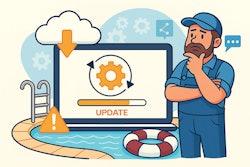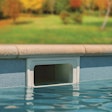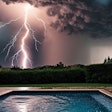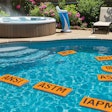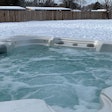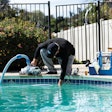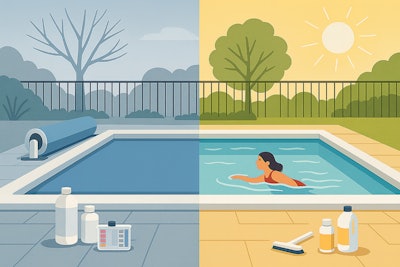
Daily temperatures of both the ambient air and the swimming pool are peaking this month. What a change from May! That rise in pool water temperature from spring to mid-summer has a big impact on chemistry and can change the approach required to accomplish the 3 P’s of Pool Care: Prevent Disease, Protect Equipment, and Provide the Expected Swimming Environment.
The transition from the cold water chemistry of opening a pool in early spring to the warm water environment of July and August has a bigger impact in places like Omaha and Salt Lake City than it does in San Diego or Texas. Regardless, as water warms, pool pros can be caught unaware of changing water conditions that can lead to necessary adjustments in the way pools are maintained and balanced. If adjustments are not made as the season progresses, problems often occur.
In the cold water months, even after the pool is open, we’re focused more than usual on equipment and surfaces because cold water chemistry is a greater threat to them — it’s more corrosive and aggressive. Our goal is to keep protecting the equipment from damage, whether that be from corrosion or scale buildup, and to ensure surfaces are protected from etching, pitting, or any other damage that can occur when water is not properly balanced and the saturation index is not properly maintained.
Is the equipment being damaged? Is the water corrosive? Is it scale forming? Those are questions to answer when we first open the pool. Later, as we transition into summer and the water warms up a bit, we’re looking more at bather comfort and the ability keep the water clean, clear and ready for swimming.
When we move to mid-season water balance, we focus on questions like: Are eyes getting red, bloodshot, or irritated? Is skin itchy? Is the water cloudy? Can you clearly see the bottom of the pool? Those are some of the questions to ask in the heart of the season. These are all key factors in the third “P” of Pool Care — providing the expected swimming environment for the user. These characteristics are less important in a cold water environment when no one is using the pool, but become more important as the water warms up.
Let’s take a look at cold water chemistry specifically, and then at the changes you see as the pool warms up during the season.
COLD WATER IS HUNGRY WATER
Water balance in cold, springtime pool water tends to be a little unique. The low temperature changes carbon dioxide chemistry, it changes calcium solubility, and it changes the aggressive nature of water. But, as always, we balance our cold water according to the three P’s of Pool Care:
- Prevent disease by sanitizing
- Protect the investment by protecting equipment and surfaces with proper water balance
- Providing the expected environment
I like to use an analogy: If you picture when it’s warm outside, you sometimes lose your appetite, but when it’s cold, you just want to sit in front of the fire and eat all the time, right? That’s how pool water behaves.
Pool water is more corrosive when it’s cold. It wants more calcium because calcium is more soluble in cold water. So, when it’s cold, it’s “hungrier” — it wants to “eat” more calcium — whereas when it gets hot, it doesn’t need as much calcium and tends to give it back, or spit it back out. When that happens, calcium is deposited on pool walls and equipment as scale. As the water slowly warms from spring into summer, its appetite for calcium changes dramatically.
At the same time, cold water makes it a lot harder to dissolve chemicals. You often notice this when adding chemicals to a cold pool. Anyone who’s ever tried a mid-winter shock treatment when the pool’s shut down and the water’s freezing knows there’s basically one choice: liquid chlorine. It doesn’t care if the water’s cold, it’s already dissolved. Whereas if you’re trying to dissolve a granular cal-hypo product or something along those lines, it’s harder to do when the water is cold.
In addition, cold water can interfere with your testing. When a pool is first opened and the initial water sample is pulled, there are a couple of things to
be aware of. First, cyanuric acid (CYA) can sometimes be masked in cold water. The colder your water gets, the harder it is to get an accurate CYA reading. The other thing to remember is that when water sits over the course of winter, it can stratify — and some chemicals settle to the bottom of the pool while others do not. You can test pH and chlorine accurately in cold water, but CYA, borates, and salt can settle toward the bottom of the pool. A sample tested before the water has been properly circulated can give you inaccurate readings for those parameters.
Why does this matter? For example, at pool opening, you might pull an immediate water sample to decide: Do I need salt? If that water hasn’t been circulated and running for 24 hours, the salt reading may not be accurate. Salt can stratify toward the bottom of the pool and will remain there until the water has turned over several times and the chemicals within the pool have been mixed up again.
CORROSION DAMAGE
Cold water tends to be more corrosive in general because pH tends to be lower. It’s not only looking for calcium, as we previously discussed, but also for any metal it can steal from the pool system’s metal parts. That process has been happening all winter to some extent — metal parts corrode, releasing metal ions into the water.
In spring, with low pH cold water, those ions tend to stay in the water. They’re less likely to precipitate out and cause discoloration or staining. But as water warms and we shift into regular summer pool care, remember what happens? Water starts to warm up and it isn’t hungry anymore, it wants to spit things out on equipment and surfaces. And, because it’s now mid-summer, pool maintenance has changed and shocking the pool is happening on a weekly basis. Shocking will often lead to a sudden pH change in the water, especially if using calcium hypochlorite or liquid chlorine. Sudden changes in pH, especially a rise in pH, will lead to metals falling out of solution and leading to staining.
What metals are we talking about? Copper, for one. Heat exchangers in your pool heater are made of copper. Corrosion in a heater is putting copper in the water (and damaging your heater). As water warms and pH changes, copper from heater damage can fall out of solution and cause staining. That’s why, at pool opening, you should add a metal sequestrant that can grab a hold of metal ions and keep them from falling out of a solution — regardless of oxidation, water temperature or pH changes — as pool maintenance moves into the warm water of summer.
Metals aren’t the only thing being eaten away during all those winter months with cold, corrosive water sitting in the pool — we get a lot of damage to pool surfaces, too. Etching occurs on plaster surfaces and vinyl liners start to wrinkle. Remember the second “P” in Pool Care is Protect the investment. If water is hungry and corrosive when it’s cold, then we’re not protecting the investment. Our surfaces are getting damaged, which means more maintenance, more upkeep and more cost to the customer. And because we’ve compromised the surface, that means more places for algae to get caught up and start growing, and more places for problems to start happening. So again, during that long cold water period, we must ensure the water isn’t corrosive.
SATURATION INDEX AND BALANCING THE POOL
Water temperature also has a big impact on the saturation index, which is used to balance the pool. The same water balance parameters that balance the saturation index in spring will become scale-forming by August.
Let me give you an example straight from the CPO manual: Say you open a pool at 53 degrees Fahrenheit, and your LSI shows a reading of 0.3, which is fine and is within the neutral range of -0.3 to 0.3. If you warm that water up to 84 degrees Fahrenheit — what I’d call swimming temperature — your LSI has risen to 0.7, which will cause calcium to precipitate. That’s a swing of 0.4 on the LSI, and a change from neutral to scale-forming, just from temperature alone! None of the water balance parameters have been adjusted. That’s why you’ve got to balance with temperature in mind — not just where it is now, but where it’s going.
The same impact must be considered when closing a pool. The pool might be 76 degrees Fahrenheit when it’s closed, but in the winter, that water drops to 37 degrees Fahrenheit. That’s another big swing — about 0.5 in the saturation index — which can turn balanced water into corrosive water. A lot of pool pros try to fix this by adding extra calcium when closing, thinking, “Cold water wants calcium, so let’s give it some.” That works... until spring, when the water warms up. When water warms up, there is excess calcium in the water, the temperature is rising, and suddenly you’re dealing with scale. And guess what? You can’t remove that calcium without draining the pool. So while it’s great for winter, it causes surface damage and accumulation problems as you transition into warmer water pool care.
Some folks try to offset this by dropping the pH in summer to keep scale from forming. That technically works, but now you’ve got low pH issues — ineffective sanitizer, red eyes, and uncomfortable swimmers. So be careful with that calcium trick. Once calcium is in, it’s in. And low pH can offset it, but not without impacting a lot of other elements to pool care that are just as important as the saturation index. In some cases, they might be considered more important.
There are a lot of things to consider as pools transition from opening to mid-summer pool care. The key is to maintain proper water balance and sanitizer residuals at all times. There are many other elements to consider as water warms up, but for now, just remember; don’t overuse calcium, manage pH carefully, and always adjust for temperature swings with an eye on our three P’s of Pool Care:
- Preventing disease by sanitizing
- Protecting the investment with water balance
- Providing the expected environment of clean clear water, ready for swimming.
This article first appeared in the August 2025 issue of AQUA Magazine — the top resource for retailers, builders and service pros in the pool and spa industry. Subscriptions to the print magazine are free to all industry professionals. Click here to subscribe.



























